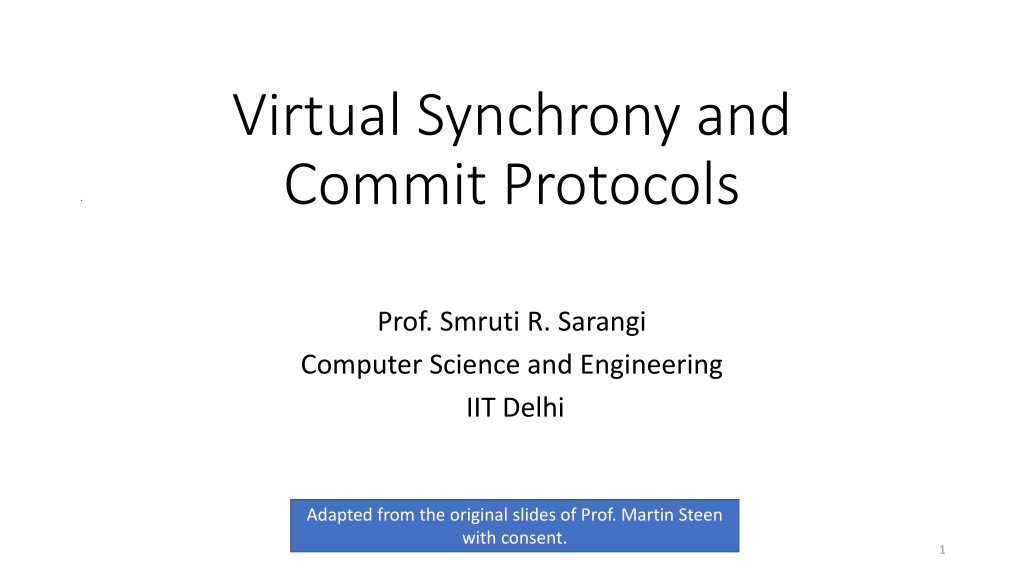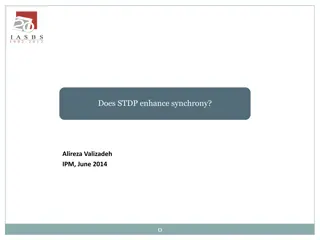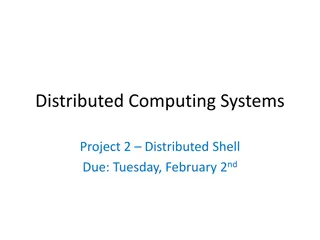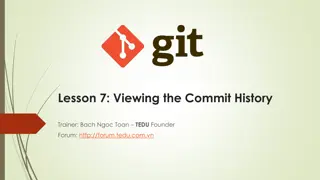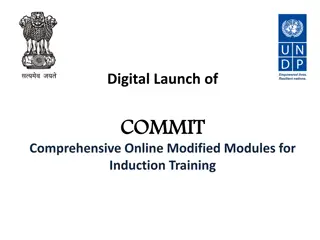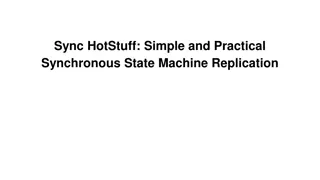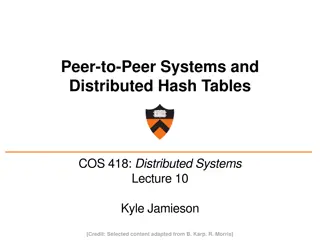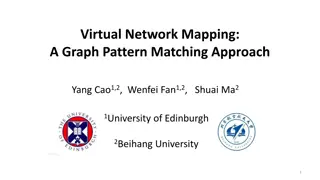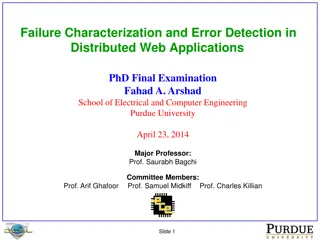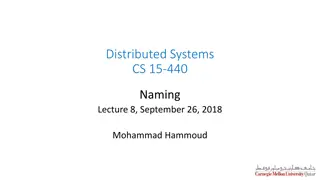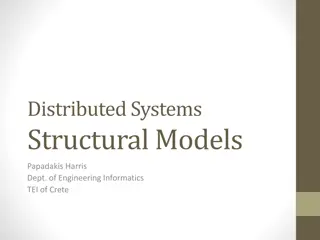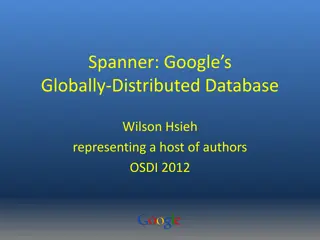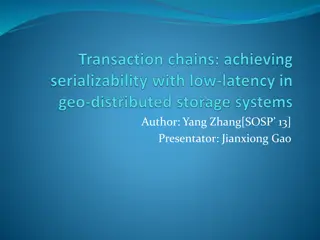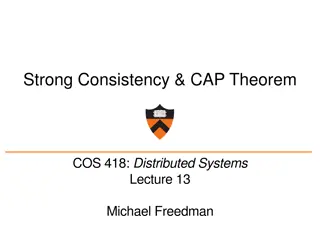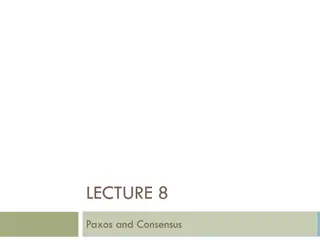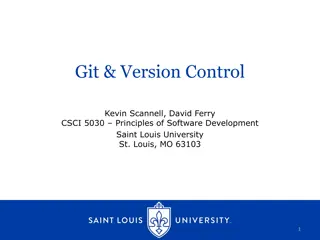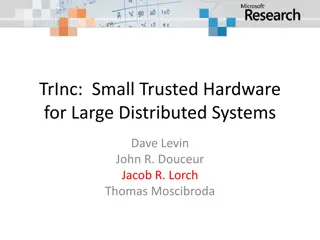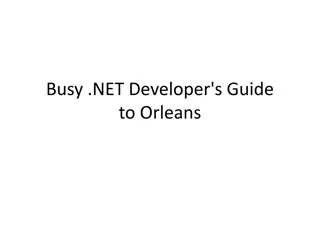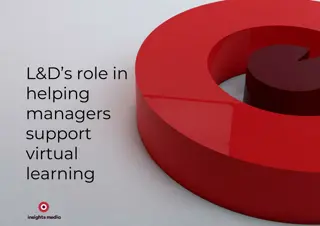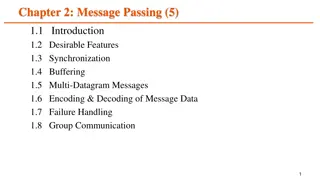Understanding Virtual Synchrony and Commit Protocols in Distributed Systems
Explore the concepts of virtual synchrony, commit protocols, and reliable multicasting in distributed systems. Learn about one-to-one communication, process groups, and virtually synchronous multicast, along with implementations in LAN environments. Discover how processes can handle failures and ensure message delivery and agreement within a group.
Download Presentation

Please find below an Image/Link to download the presentation.
The content on the website is provided AS IS for your information and personal use only. It may not be sold, licensed, or shared on other websites without obtaining consent from the author. Download presentation by click this link. If you encounter any issues during the download, it is possible that the publisher has removed the file from their server.
E N D
Presentation Transcript
Virtual Synchrony and Commit Protocols Prof. Smruti R. Sarangi Computer Science and Engineering IIT Delhi Adapted from the original slides of Prof. Martin Steen with consent. 1
One-to-one Communication: Unicasting Client Server Client-server Messages can get lost. There is a need to resend messages. Two commonly used semantics At-least-once semantics: The operation will be carried out by the server at least once. At-most-once semantics: The operation will be carried out at most once. 3
Notion of Process Groups: Multicasting Processes can exhibit all kinds of failures Fail-silent: Just fails without any intimation. Fail-stop: The failure can be detected. Fail-safe: The failure is benign. Create a group of processes to service the client s request Replicate the state across processes Give the same user input to all the processes, collate the outputs, and decide the result based on voting Failure tolerance To tolerate k fail-stop failures, we need k+1 processes. If processes produce arbitrary outputs, we need 2k+1 processes (use voting) If the process sending the input is malicious, we need 3k+1 processes (Byzantine) 4
Reliable Multicasting Define a multicast channel, c Sender group SND(c) Processes that can send messages on channel c Receiver group RCV(c) Processes that can receive messages on channel c Reliability guarantee If process ? ???(?), message m should be delivered to p, as long as p does not change its membership throughout the duration of the message transfer. Atomicity guarantee If message m is delivered to process p, then m is delivered to all the processes in RCV(c) 5
Implementation in a LAN Sender Receiver Receiver Receiver ACK The sender sends a message to a set of receivers One of them sends an acknowledgement (ACK) on a shared channel The rest snoop the message If any receiver hasn t gotten the original message, it requests for a re- transmission 6
Virtually Synchronous Multicast Processes can fail at any time Hence, we need to change our definitions Virtually synchronous multicast A message is delivered to all non-faulty members of the group All the members agree on the current group membership View ? ??? ? ???(?) Processes are added or deleted by view changes In a stable state, all the processes agree on the current view All non-faulty processes see all view changes in the same order 7
Virtually Synchronous Multicast View Changes Let us say that view V changes to view V* If a message m is sent to V before the view change, then either all ? (? ? ), receive m, or none do. All non-faulty processes in the same view get to see the same set of multicast messages. A message sent to view V can be delivered only to processes in V, and not to successive views. 8
Example of Virtual Synchrony P1 P2 P3 P4 G = {P1, P3, P4} G = {P1, P2, P3, P4} G = {P1, P2, P4} G = {P1, P2, P3, P4} 9
Few more assumptions A sender to a view V should be a member of view(V) Many people define virtual synchrony by relaxing this assumption If a sender ? ? crashes First we flush its multicast message (if possible) Then remove s from V As long as s is a member of V, all the assumptions of virtual synchrony continue to hold If a receiver ? ? crashes We can either deliver the message later (rest of the processes in the view have a copy) Or remove the receiver from the view. Virtual synchrony is independent of the order of message delivery. 10
Implementation We define ????(?) for process p as follows If ? ????(?) then ? ????(?) Messages received by p are queued in ?????(?) If p fails: First flush the messages sent by p if they are not delivered to any process in the view. Ensure all the outstanding messages are delivered. Then remove p from the group (view) Sending a message Attach a timestamp with each message (increases by 1 with every send) Assume FIFO channels Highest numbered message from q that is received by p is stored in ?????[?] 11
Implementation - II p periodically sends ?????[]to all the processes in its view Each process p records ????? (from any other process q) in an array ???????[][]. ???????? [] indicates what p knows about message arrival in node q Consider a sample remote[][] array P1 2 3 1 3 P2 2 3 1 4 1 1 1 5 P3 Find the minimum in each column P4 2 2 1 5 min 1 1 1 4 12
Stability and Flushing of Messages [Details] A message is stable if it has been received by all the processes in the view (refer to the min. vector) The message can be delivered to the process s next layer To remove a process a failure-detecting process needs to multicast a flush message to all the processes in the view. All the processes stop sending new messages. Processes send their rcvd arrays to other processes. They also elect a leader (coordinator). Once a process finds that its messages have all been received, and it has received all the messages it sends a flush_ok message to the coordinator. Otherwise, after a timeout it sends its list of unstable messages. If the coordinator does not get all the flush_ok messages in a given interval, it collects all the unstable messages, and multicasts them again. After getting acknowledgements, it sends a view_change message. 13
Commit Protocols Either all of them commit or abort. Bank Agreement Data center Credit card machine Airline 15 User
2-Phase Commit The nodes elect a coordinator Phase 1a: Coordinator sends a Vote-request message to all participants. Phase 1b: A participant returns either Vote-commit or Vote-abort Phase 2a: Coordinator collects all the votes. If all are Vote-commit it sends a Global-commit message, otherwise it sends a Global-abort message to all. Phase 2b: Each participant waits for the messages from Phase 2a. It acts accordingly. 16
2-Phase Commit Vote-Request Vote-Abort INIT INIT Vote-Request Vote-Commit - Vote Request READY WAIT Global-abort ACK Global-commit ACK Vote-Abort Global-abort Vote-Commit Global-commit ABORT COMMIT ABORT COMMIT Coordinator Participant 17
Analysis of 2-Phase Commit Let s say a participant fails, recovers and then restores its old state. INIT state: No problem. It just aborts. READY state: It needs to know the global decision (commit or abort) after it recovers. Ask the coordinator or other participants. This is very problematic. The coordinator might have failed. Other processes might have committed or aborted. They might have erased all the history of the transaction. We will never know what decision the coordinator took. ABORT state: Complete the abort process. COMMIT state: Complete the commit process. 18
3-Phase Commit The nodes elect a coordinator Phase 1a: Coordinator sends a Vote-request message to all participants. Phase 1b: A participant returns either Vote-commit or Vote-abort Phase 2a: Coordinator collects all the votes. If all are Vote-commit it sends a Prepare-commit message, otherwise it sends a Global-abort message to all. Phase 2b: Each participant waits for the messages from Phase 2a. If it gets a Prepare-commit message, it proceeds to send a Ready-commit message, else it aborts. Phase 3a: After the coordinator gets all the Ready-commit messages it sends a Global-commit message to all the participants. Phase 3b: The participants wait for the Global-commit message. 19
3-Phase Commit Vote-Request Vote-Abort INIT INIT Vote-Request Vote-Commit - Vote Request READY WAIT Global-abort ACK Prepare-Commit Ready-Commit Vote-Abort Global-abort Vote-Commit Prepare-Commit ABORT ABORT PRECOMMIT PRECOMMIT Ready-Commit Global-commit Global-commit ACK COMMIT COMMIT Coordinator Participant 20
Analysis Consider the READY and PRECOMMIT states. If a participant fails in the READY state: It can ask the coordinator. If the coordinator has failed, then we can elect a new coordinator. If any process has gotten a PRECOMMIT message, then they proceed towards a global commit. Else all processes abort. PRECOMMIT state: Elect a new coordinator that will send a Global-commit message. Coordinator fails in the WAIT state: Participants time out in the READY state PRECOMMIT state: Participants time out in the PRECOMMIT state 21
References 1. Tanenbaum, Andrew S., and Maarten Van Steen. Distributed systems: principles and paradigms. Prentice-Hall, 2007. [Thanks to Prof. Martin Steen for allowing us to adapt his original slides. ] https://www.distributed-systems.net/index.php/books/ds2/ 22
Thank you 23
